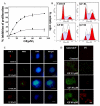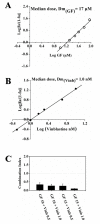Griseofulvin stabilizes microtubule dynamics, activates p53 and inhibits the proliferation of MCF-7 cells synergistically with vinblastine
- PMID: 20482847
- PMCID: PMC2885362
- DOI: 10.1186/1471-2407-10-213
Griseofulvin stabilizes microtubule dynamics, activates p53 and inhibits the proliferation of MCF-7 cells synergistically with vinblastine
Abstract
Background: Griseofulvin, an antifungal drug, has recently been shown to inhibit proliferation of various types of cancer cells and to inhibit tumor growth in athymic mice. Due to its low toxicity, griseofulvin has drawn considerable attention for its potential use in cancer chemotherapy. This work aims to understand how griseofulvin suppresses microtubule dynamics in living cells and sought to elucidate the antimitotic and antiproliferative action of the drug.
Methods: The effects of griseofulvin on the dynamics of individual microtubules in live MCF-7 cells were measured by confocal microscopy. Immunofluorescence microscopy, western blotting and flow cytometry were used to analyze the effects of griseofulvin on spindle microtubule organization, cell cycle progression and apoptosis. Further, interactions of purified tubulin with griseofulvin were studied in vitro by spectrophotometry and spectrofluorimetry. Docking analysis was performed using autodock4 and LigandFit module of Discovery Studio 2.1.
Results: Griseofulvin strongly suppressed the dynamic instability of individual microtubules in live MCF-7 cells by reducing the rate and extent of the growing and shortening phases. At or near half-maximal proliferation inhibitory concentration, griseofulvin dampened the dynamicity of microtubules in MCF-7 cells without significantly disrupting the microtubule network. Griseofulvin-induced mitotic arrest was associated with several mitotic abnormalities like misaligned chromosomes, multipolar spindles, misegregated chromosomes resulting in cells containing fragmented nuclei. These fragmented nuclei were found to contain increased concentration of p53. Using both computational and experimental approaches, we provided evidence suggesting that griseofulvin binds to tubulin in two different sites; one site overlaps with the paclitaxel binding site while the second site is located at the alphabeta intra-dimer interface. In combination studies, griseofulvin and vinblastine were found to exert synergistic effects against MCF-7 cell proliferation.
Conclusions: The study provided evidence suggesting that griseofulvin shares its binding site in tubulin with paclitaxel and kinetically suppresses microtubule dynamics in a similar manner. The results revealed the antimitotic mechanism of action of griseofulvin and provided evidence suggesting that griseofulvin alone and/or in combination with vinblastine may have promising role in breast cancer chemotherapy.
Figures






Similar articles
-
An antitubulin agent BCFMT inhibits proliferation of cancer cells and induces cell death by inhibiting microtubule dynamics.PLoS One. 2012;7(8):e44311. doi: 10.1371/journal.pone.0044311. Epub 2012 Aug 31. PLoS One. 2012. PMID: 22952952 Free PMC article.
-
Thalidomide (5HPP-33) suppresses microtubule dynamics and depolymerizes the microtubule network by binding at the vinblastine binding site on tubulin.Biochemistry. 2015 Mar 31;54(12):2149-59. doi: 10.1021/bi501429j. Epub 2015 Mar 17. Biochemistry. 2015. PMID: 25747795
-
NMK-TD-100, a novel microtubule modulating agent, blocks mitosis and induces apoptosis in HeLa cells by binding to tubulin.PLoS One. 2013 Oct 7;8(10):e76286. doi: 10.1371/journal.pone.0076286. eCollection 2013. PLoS One. 2013. PMID: 24116100 Free PMC article.
-
Microtubule assembly dynamics: an attractive target for anticancer drugs.IUBMB Life. 2008 Jun;60(6):368-75. doi: 10.1002/iub.42. IUBMB Life. 2008. PMID: 18384115 Review.
-
Microtubules and Cell Division: Potential Pharmacological Targets in Cancer Therapy.Curr Drug Targets. 2023;24(11):889-918. doi: 10.2174/1389450124666230731094837. Curr Drug Targets. 2023. PMID: 37519203 Review.
Cited by
-
Keep Calm and Carry on with Extra Centrosomes.Cancers (Basel). 2022 Jan 17;14(2):442. doi: 10.3390/cancers14020442. Cancers (Basel). 2022. PMID: 35053604 Free PMC article. Review.
-
HPLC-MS/MS Method for the Detection of Selected Toxic Metabolites Produced by Penicillium spp. in Nuts.Toxins (Basel). 2020 May 8;12(5):307. doi: 10.3390/toxins12050307. Toxins (Basel). 2020. PMID: 32397224 Free PMC article.
-
Identification of novel small molecule inhibitors of centrosome clustering in cancer cells.Oncotarget. 2013 Oct;4(10):1763-76. doi: 10.18632/oncotarget.1198. Oncotarget. 2013. PMID: 24091544 Free PMC article.
-
Regiodivergent addition of phenols to allylic oxides.J Org Chem. 2015 May 15;80(10):5252-9. doi: 10.1021/acs.joc.5b00671. Epub 2015 May 1. J Org Chem. 2015. PMID: 25933102 Free PMC article.
-
Bioactive Polyketides from the Natural Complex of the Sea Urchin-Associated Fungi Penicillium sajarovii KMM 4718 and Aspergillus protuberus KMM 4747.Int J Mol Sci. 2023 Nov 21;24(23):16568. doi: 10.3390/ijms242316568. Int J Mol Sci. 2023. PMID: 38068891 Free PMC article.
References
-
- Ho YS, Duh JS, Jeng JH, Wang YJ, Liang YC, Lin CH, Tseng CJ, Yu CF, Chen RJ, Lin JK. Griseofulvin potentiates antitumorigenesis effects of nocodazole through induction of apoptosis and G2/M cell cycle arrest in human colorectal cancer cells. Int J Cancer. 2001;91:393–401. doi: 10.1002/1097-0215(200002)9999:9999<::AID-IJC1070>3.0.CO;2-#. - DOI - PubMed
Publication types
MeSH terms
Substances
LinkOut - more resources
Full Text Sources
Other Literature Sources
Medical
Research Materials
Miscellaneous

